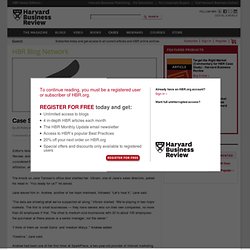

Case Study: Target the Right Market - Jill Avery and Thomas Steenburgh. Editor’s Note: This fictionalized case study will appear in a forthcoming issue of Harvard Business Review, along with commentary from experts and readers.

If you’d like your comment to be considered for publication, please be sure to include your full name, company or university affiliation, and email address. The knock on Jane Tamsen’s office door startled her. Vikram, one of Jane’s sales directors, poked his head in. “You ready for us?” He asked. Jane waved him in. “The data are showing what we’ve suspected all along,” Vikram started. “I think of them as ‘small Sams’ and ‘medium Marys,’” Andrew added. “Creative,” Jane said. Andrew had been one of her first hires at SparkPlace, a two-year-old provider of internet marketing software, and he’d continued to impress her. Jane had been Dirk’s third employee, and although they didn’t always see eye-to-eye, they agreed completely about the company’s mission.
“Where does the analysis say we should focus?” “They love us,” Vikram chimed in. “OK. Strategy on One Page - Anthony Tjan. By Anthony K.

Tjan | 8:40 AM June 1, 2011 My partner Mats Lederhausen, formerly worldwide head of strategy for McDonald’s, introduced me to “Strategy Trees.” The concept is, like most useful things, deceptively simple. It forces you to get at the heart of what you are trying to achieve. The “tree” analog comes from the linkage between the questions in a Strategy Tree.
It comes down to asking the “Why, what, who, and how” of your business, arraying it across one page in a way that makes it extremely useful as an alignment tool amongst management or board members. 2. 3. 4. The Strategy Tree is a variant of a decision tree, except it is less about forcing choices along a path than simply outlining a path for strategic purpose and growth. Why That New Innovation Effort May Not Be Worth It - Vijay Govindarajan and Manish Tangri. By Vijay Govindarajan and Manish Tangri | 2:16 PM June 25, 2012 Nowadays, almost every company claims to be innovative, if only to attract top talent, please investors, and strengthen its brand.

Some companies are innovative, but many are not. If you are going to lead or be a part of a new initiative, how can you tell if your organization is really committed to supporting that effort? Is the innovation effort only inducing fear, uncertainty, and doubt in the market, or is the company really walking the talk? Or is this just another aspirational flavor of the month? Innovation readiness depends on two key factors: motivation and competence.
Motivation: How hungry are you for innovation? The Leader: Understanding the leader’s motivation is the critical first step. The Team: Does the team believe in the vision and the leader? The Organization: What motivates the urgency for innovation? Ted Goff Cartoons Gallery. Comic strip for 07/06/2012 from the official Dilbert comic strips archive.